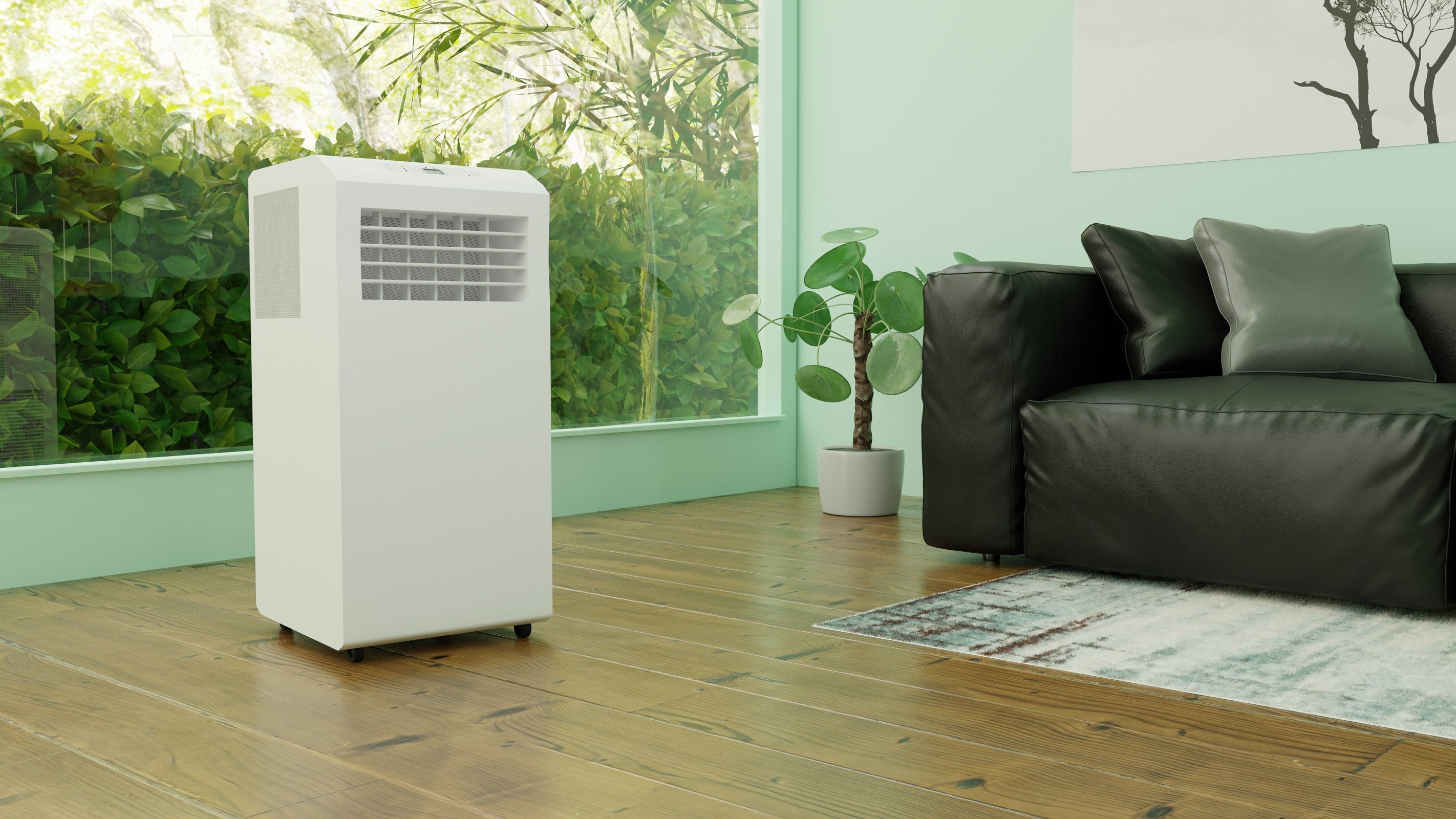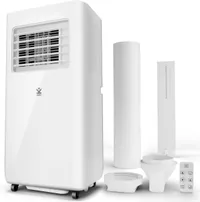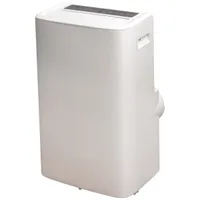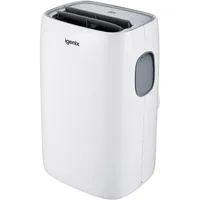Is a portable air con the way to beat the summer heat wave? I’ve owned one for two years, and here are the pros and cons
I love it, but there are things to know before buying

The heat wave is truly upon the UK. Well, another heat wave, I should probably say. I know a lot of people are looking at ways to cool down right now, including fans and – if you're going hardcore – air conditioners. There are options for both among this year's Amazon Prime Day deals, and we've got a round-up of the best Prime Day fan deals we've spotted – but I'm here to talk the portable air con side.
• Browse Amazon's full Prime Day sale
A couple of years ago, I decided that fans weren't cutting it in my home, and I bought a portable air con. After two summers of use, I've learned a few things about using them I think will be useful for anyone looking to buy one today, so here are some tempting air con deals I've spotted, followed by my advice about owning one.
One thing to note before I start: air cons are categorised by their BTU capacity. This stands for British Thermal Units, and the higher the BTU capacity, the larger the room that it can effectively cool. As I'll come to in a minute, I think you should look for 10000 BTU as a minimum, and 12000 BTU preferably at least.
Portable air con deals on Prime Day
In terms of capacity balanced with price, this is hard to beat this year – 10000 BTU will be enough for most UK bedrooms and smaller living rooms.
This is basically the unit I have – mine was Meaco-branded, and this is amusingly unbranded, but the design and controls are identical. It works great for me, and 12,000 BTU is good for a lot of rooms.
A low price for a 12,000 BTU air con. The listing on Amazon doesn't mention important accessories like the ducting, but the manual says it comes with this stuff.
7 things to know before buying a portable air conditioner
1. What comes next will all be worth it
I'm about to give you six difficulties with owning a portable air con, and I don't want this article to come across like I'm trying to put you off. I'm delighted with mine, and life would be measurably worse without it. I cannot tell you how amazing it is to sleep in a room that's a steady 18 degrees when it's 28 degrees outside. It's 100% worth it – but you definitely need the whole lowdown. So let's get into it.
2. You probably need a bigger capacity than you think
You can find cheap air cons with 7000 BTU or 8000 BTU capacities, and these are also smaller and lighter than larger air cons. But unless you're buying the air con solely to live in a small bedroom or office, I don't recommend this. My 12000 BTU air conditioner takes a fair amount of time to cool my bedroom, and it's not very large.
And you'll note that during this whole thing, I'm talking about cooling individual rooms only – for best results, you not only want a fairly large unit, you need to close the door to the room, because mid-size units won't be able to cool a whole floor of your house (or two floors if your stairs aren't closed off).
A 12,000 BTU unit is good for a room size of around 20-25m2 at most, but I use mine in rooms smaller than that and it still takes time to work well – and in my living room, it's basically the correct size. But I rarely move it to my living room…
3. If you have stairs, you might want two
These things are heavy. I can move it up and down stairs on my own slowly, going from step to step – because not only are they heavy, but you don't want to risk any issues with the coolant system from aggressive movement or bashing – but my partner can't.
So while I can move it up and down, I really don't want to… so mine is just a bedroom air con, moving upstairs on its wheels as needed. If you need relief downstairs, as well, consider saving up for a second unit.
4. Venting and power really affect where you can put them
Air cons need to vent the heat extracted from the air, and you obviously don't want that warmed-up air going back into your house. So they come with ducts that need to go out of a window, but the ones included with your air con won't be very long. And probably neither is the power cable.
So the air con will need to operate within 1m or so of a window, and probably 2m of a plug socket, so just bear that in mind – it's often not recommended to use them with extension cords, though you will likely be okay with a high-quality one. You may be able to buy a longer duct, though again, your unit may not recommend this – it's harder to push the air through a longer duct, so this will be especially be tough for a lower-BTU unit.
5. Don't open windows and ruin it – and blocking them isn't always easy
Your air con will work best in a sealed room – do not open the windows and doors to let air 'flow'. Presumably, the air outside is warmer than the air in the room, otherwise you wouldn't need an air con – so you're just counteracting the work of the air con if you let it in! The same goes after the air con has reached target temperature – if you've got it to 20 degrees inside and the air is still 24 outside, don't open the windows for 'fresh' air and undo all the work.
However, as I mentioned above, you still need to vent the air out, and a window is the easiest place to do this. That means you need to seal the window off, with a hole for the duct to escape through. Air cons will usually come with a plastic barrier that can be used for sliding or sash windows. If you have hinged windows, they usually come with velcro-based options.
I have hinged windows, and I have never been able to get the velcro options from my air con to stay in place well. That's partly because my windows are a little old and annoying designed, and partly because it's just not the sturdiest solution. I instead fashioned a cardboard blocking panel, with a hole cut to the right size for the duct, which wedges nicely into my window frame. I'm not saying you'll have to do the same, I'm just saying this may be a pain point you need to figure out.
6. Cooling isn't fast – for best results, let it run all day
When you turn on the air con, you will feel the blissful relief of actively cold air passing over you right away. They'll give you some personal benefits the second you plug them in, so that's great.
However, to cool the room overall takes hours, and this is what you want for a pleasant sleep. Turning the air con on for a little while before bed will help, but for the best result, let it run all day, from morning until night. It's far easier for them to maintain the lower temperatures from overnight than to only start cooling once it's got really hot – they don't run when they're not needed. If it's cool enough, they'll ramp down into low-power mode.
7. They're big and they need to be stored somewhere
You've also got to think about when it's not hot! These things are big – my 12000 BTU unit is about half the size of an under-counter fridge. And with this weight, you will not be taking it up and down the attic ladder.
I've got a space carved out in my spare room's closet for it to live in over the colder months, where it's basically out of the way. You'll need something similar, or just a corner where you're happy for it to stay.
More of today's best Amazon Prime Day deals
- Amazon Devices: up to 50% off Kindle & Ring
- Appliances: Ninja & De'Longhi from £29.99
- Gaming: Nintendo Switch 2 – in stock now
- Headphones: Bose & Sony from £14.99
- Health: up to 68% off Philips, Remington & Oral-B
- Home: fans from £12.99
- Laptops: Lenovo, Asus and HP from £139
- Phones: up to 30% off Apple & Samsung
- Tablets: iPads & Fire Tabs from £59.99
- Toys: up to 50% off Lego & Mattel
- TVs: cheap TVs from £99.99
- Vacuums: Shark and eufy from £99
- Wearables: Huawei & Samsung from £39
Sign up for breaking news, reviews, opinion, top tech deals, and more.

Matt is TechRadar's Managing Editor for Entertainment, meaning he's in charge of persuading our team of writers and reviewers to watch the latest TV shows and movies on gorgeous TVs and listen to fantastic speakers and headphones. It's a tough task, as you can imagine. Matt has over a decade of experience in tech publishing, and previously ran the TV & audio coverage for our colleagues at T3.com, and before that he edited T3 magazine. During his career, he's also contributed to places as varied as Creative Bloq, PC Gamer, PetsRadar, MacLife, and Edge. TV and movie nerdism is his speciality, and he goes to the cinema three times a week. He's always happy to explain the virtues of Dolby Vision over a drink, but he might need to use props, like he's explaining the offside rule.
You must confirm your public display name before commenting
Please logout and then login again, you will then be prompted to enter your display name.


